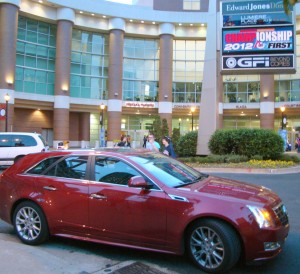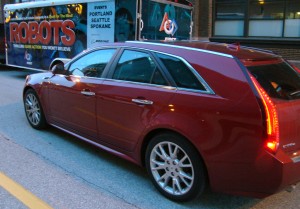ST. LOUIS – Someday, the high-energy teenagers competing at the FIRST Robotics World Championship may be the ones designing some future successor to this Cadillac CTS Sport Wagon.
In fact, General Motors is counting on it. That’s why the automaker sponsors 74 teams in the international competition. In fact, the company estimates that it has reached 10,000 students – in the last year alone.
We were in St. Louis because our son is a member of the H.O.T. Team #67, which is a partnership between GM’s Milford Proving Grounds and Huron Valley Schools in Milford, Mich. Every year, proving ground engineers with the highly decorated team mentor the high school students as they build a robot to compete in the FIRST Robotics Competition. FIRST introduces a new game every year so each robot has to be designed to play that year’s game.
The goal behind FIRST is to encourage young people to study science, technology, engineering and technology (STEM). And GM is hoping some of those young people might be the next designers, engineers and technologists who will make some future generation of what is generally recognized as the automaker’s best car.
Truth be told, the current version is already pretty good.
It took a while, but Cadillac has finally realized offering multiple varieties of a great car is the way to win more buyers. So, joining the superb sedan in 2010, Cadillac added the utilitarian Sport Wagon and in 2011 came the slinky coupe. There are also V versions of each, allowing Cadillac to lay claim to the title of world’s most powerful sedan and wagon.
For our 1,100-mile trip to Gateway City, we drove a loaded Crystal Red CTS Sport Wagon. The car proved to be a very good steed for three people with robots on their minds, although, were it ours, there are a few option boxes we would have left unchecked.
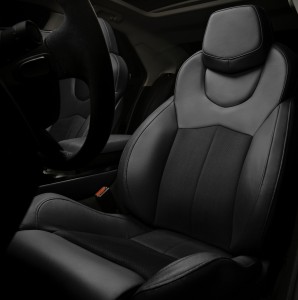
The Touring package includes Recaro "High Performance" seats. Make sure you spend considerable time sitting on these thrones before ordering them.
Powered by a 318-horsepower, 3.6-liter V-6, the wagon had plenty of power for passing on a section of the fabled Route 66 that we took to avoid construction on the freeway just outside of St. Louis. While GM uses this engine in everything from the Chevy Malibu sedan to the Traverse crossover, in no other vehicle does it sound better than in CTS tune.
The CTS was smooth, quiet at speed and fun to drive. That it has the extra space provided by trading a trunk for the wagon shape goes unnoticed by the driver. Well, except that the narrow rear window is significantly farther back than in the sedan.
About those options. The $2,810 CTS Touring package, among other elements, includes Recaro “high performance” leather seats with “sueded fabric” inserts and a “sueded” steering wheel.
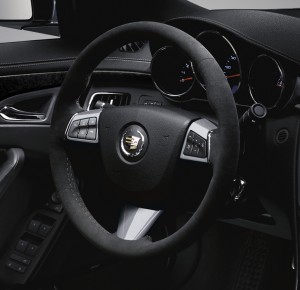
The CTS Touring package includes a "sueded" steering wheel. The Premium trim level's heated wood and leather wheel would be better.
Young racers at heart would probably love these multi-adjustable seats. But anyone packing a few extra pounds and a few more years may not like them. We found the adjustable bolsters difficult to climb over and too confining, even when set in the most relaxed settings. The seats were thinly padded and made for an uncomfortable ride on our long haul to St. Louis.
While they are uncomfortable, they will hold you in place like the Le Brea tar pits hold onto a sabertooth tiger. The deep bolsters and grippy, sueded fabric – often called by the brand name Alcantara – make sure your backside stays planted, no matter what kind of handling tomfoolery you’re engaged in.
Anyone thinking about checking the Touring package box should invest considerable seat time to make sure the Recaros are to their liking. The cushier standard seats are more comfortable and make ingress and egress easier, even if they don’t hold passengers quite as firmly.
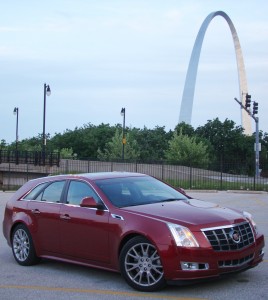
Pictures of the car with the Gateway Arch in the background are essentially mandatory when visiting St. Louis.
Regardless what the front-seat passengers are sitting on, those in back have comfy seats and decent legroom. Headroom is just acceptable. The beautifully finished cargo area has twin aluminum rails with beefy tie-down hooks that slide in the rails. The extra space makes the Sport Wagon one of the most useful driver’s cars on the market.
The dash design has become somewhat dated, especially compared to some of GM’s newer designs. Still, the pop-up nav screen is cool and a real conversation starter. GM is working on new voice-activated infotainment systems. The system in the CTS is frustratingly simplistic and understands very few commands, especially compared to Ford’s Sync system.
Speaking of nav, the system in the CTS had some surprising hiccups. At times, it went silent when there was a choice between freeway ramps.
The other oddity in the Touring package is the Alcantara-covered steering wheel. Replacing the heated wood and leather steering wheel that is standard in the CTS Premium, the fuzzy suede-like wheel just feels weird. Does anyone really think this is better than the standard leather and wood wheel – with heat?
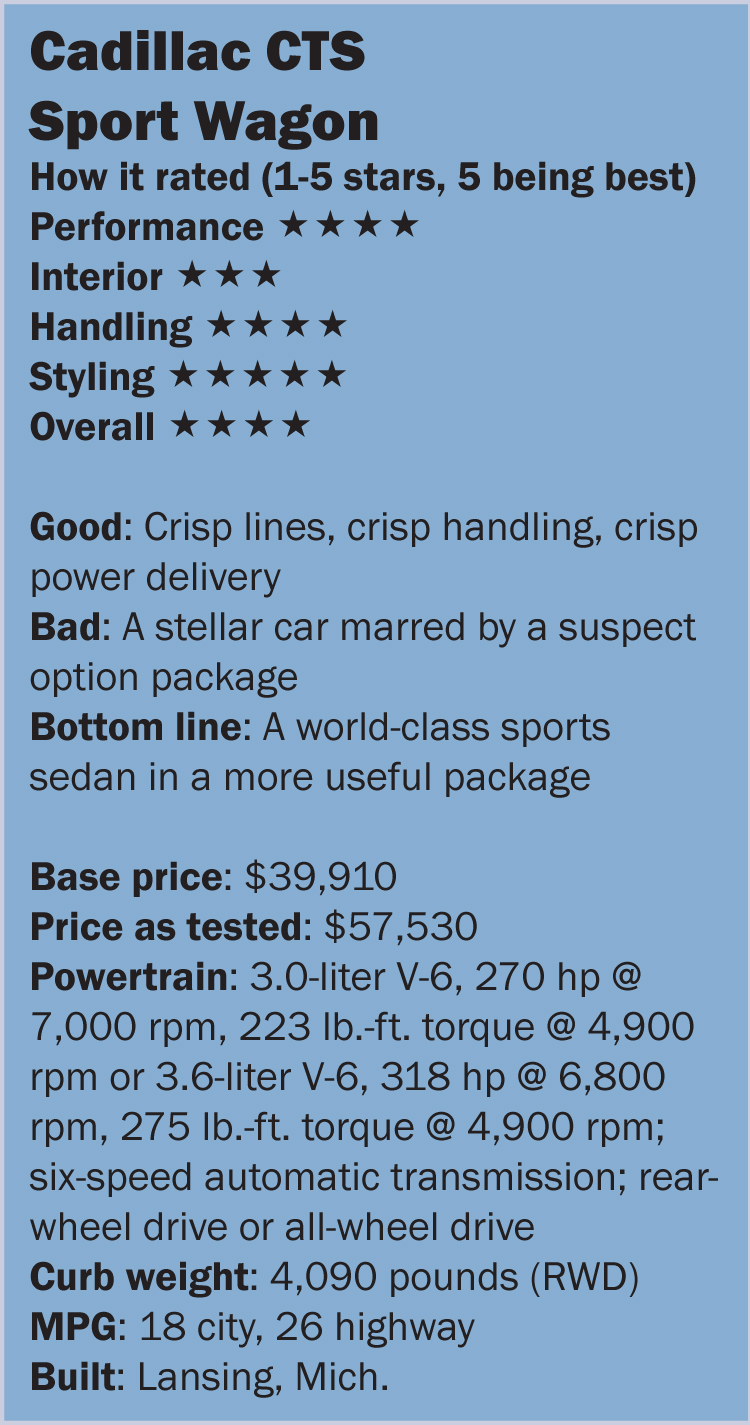 The only other issue was with the rain-sensing wipers, which are standard on the Premium trim level. Like a lot of these systems, they are too quick to jump to the fast wiper setting. Someone needs to tell carmakers that a lot of drivers – your humble author included – NEVER use the fast wiper setting. There should either be an option to disable the auto-sensing system or stop allowing this setting to automatically access the fast wiper setting.
The only other issue was with the rain-sensing wipers, which are standard on the Premium trim level. Like a lot of these systems, they are too quick to jump to the fast wiper setting. Someone needs to tell carmakers that a lot of drivers – your humble author included – NEVER use the fast wiper setting. There should either be an option to disable the auto-sensing system or stop allowing this setting to automatically access the fast wiper setting.
The CTS wagon starts at $39,910, including delivery, with the standard 270-horsepower, 3.0-liter V-6. The Premium model tested here starts at $50,645 with the 3.6-liter. Loaded with all-wheel drive ($1,900) Touring package, upgraded wheels ($850), Crystal Red clearcoat ($995) and a compact spare ($350) that replaces the standard tire inflation kit, the test car totaled $57,530.
In the end, the H.O.T. Team lost in the finals of its regional, on a field called Archimedes (all FIRST Robotics fields are named for renowned scientists), one step below the competition’s “final four” championship faceoff.
But FIRST is about so much more than wins and losses. Whether their team is among the FIRST elite or a rookie team just still trying to figure out the basics of a good drive system, the young people who take part are the big winners.
And so are the drivers who will someday have the pleasure of driving their 2030 Cadillac with the latest super electric ion technology, undoubtedly developed with the help of some FIRST alum.
Click here to learn more about FIRST Robotics.

